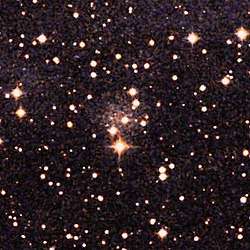Andromeda XVIII
| Andromeda XVIII | |
|---|---|
 DSS image of Andromeda XVIII | |
| Observation data (J2000 epoch) | |
| Constellation | Andromeda |
| Right ascension | 00h 02m 14.5s[1] |
| Declination | +45° 05′ 20″[1] |
| Helio radial velocity | −326.2 ± 2.7[2] |
| Distance | 4,420 ± 290 kly (1,355 ± 88 kpc) |
| Group or cluster | Local Group |
| Apparent magnitude (V) | 15.50 ± 0.24[3] |
| Absolute magnitude (V) | −10.41 ± 0.28[3] |
| Characteristics | |
| Type | dG[1] |
| Mass | 4.2×106 ± 0.3×106[3] M☉ |
| Half-light radius (physical) | 325 ± 24[2] |
| Other designations | |
| PGC 5056918[4] | |
Andromeda XVIII, discovered in 2008, is a dwarf spheroidal galaxy (has no rings, low luminosity, much dark matter, little gas or dust), which is a satellite of the Andromeda Galaxy (M31). It is one of the 14 known dwarf galaxies orbiting M31. It was announced in 2010 that the orbiting galaxies lie close to a plane running through M31's center.
See also
References
- 1 2 3 McConnachie, Alan W; Huxor, Avon; Martin, Nicolas F; Irwin, Mike J; Chapman, Scott C; Fahlman, Gregory; Ferguson, Annette M. N; Ibata, Rodrigo A; Lewis, Geraint F; Richer, Harvey; Tanvir, Nial R (2008). "A Trio of New Local Group Galaxies with Extreme Properties". The Astrophysical Journal. 688 (2): 1009. arXiv:0806.3988. Bibcode:2008ApJ...688.1009M. doi:10.1086/591313.
- 1 2 Collins, Michelle L. M; Chapman, Scott C; Rich, R. Michael; Ibata, Rodrigo A; Martin, Nicolas F; Irwin, Michael J; Bate, Nicholas F; Lewis, Geraint F; Peñarrubia, Jorge; Arimoto, Nobuo; Casey, Caitlin M; Ferguson, Annette M. N; Koch, Andreas; McConnachie, Alan W; Tanvir, Nial (2013). "A Kinematic Study of the Andromeda Dwarf Spheroidal System". The Astrophysical Journal. 768 (2): 172. arXiv:1302.6590. Bibcode:2013ApJ...768..172C. doi:10.1088/0004-637X/768/2/172.
- 1 2 3 Makarova, L. N; Makarov, D. I; Karachentsev, I. D; Tully, R. B; Rizzi, L (2017). "Star formation history of And XVIII: a dwarf spheroidal galaxy in isolation". Monthly Notices of the Royal Astronomical Society. 464 (2): 2281. arXiv:1609.09706. Bibcode:2017MNRAS.464.2281M. doi:10.1093/mnras/stw2502.
- ↑ "NAME Andromeda XVIII". SIMBAD. Centre de données astronomiques de Strasbourg. Retrieved 19 September 2017.
This article is issued from
Wikipedia.
The text is licensed under Creative Commons - Attribution - Sharealike.
Additional terms may apply for the media files.
.jpg)